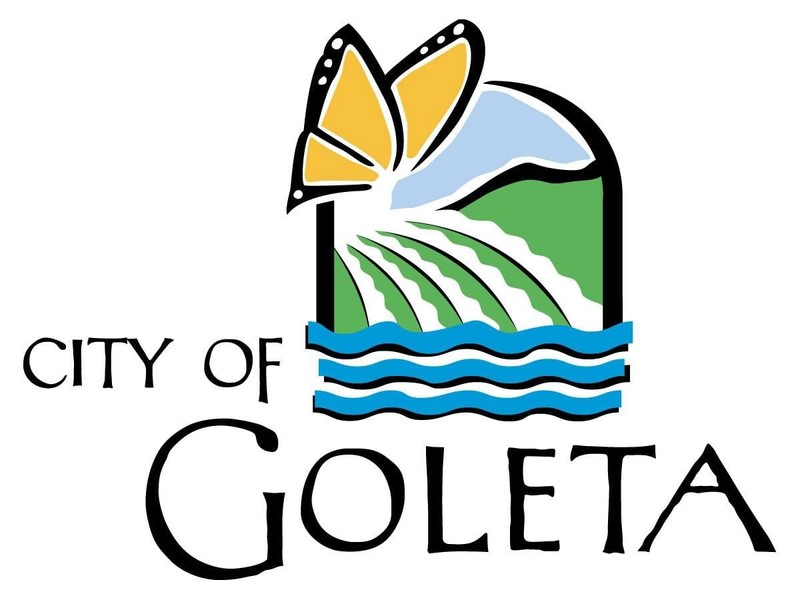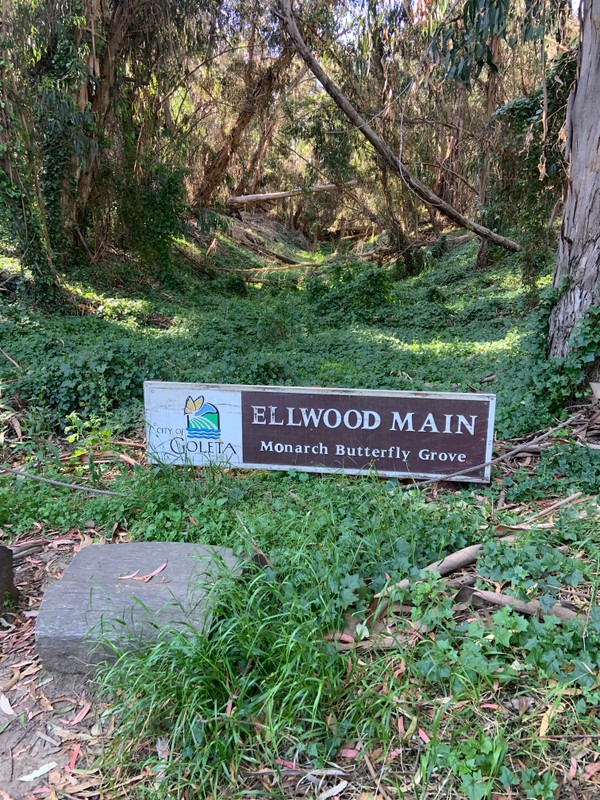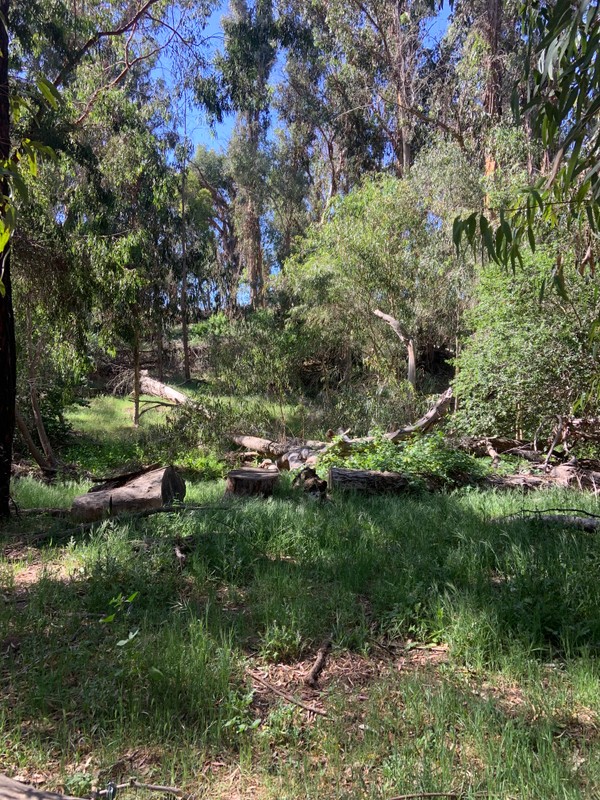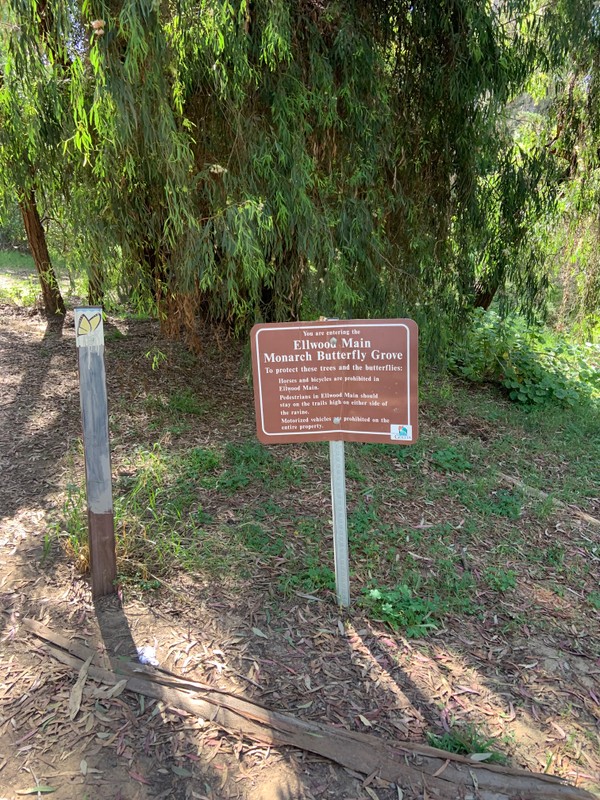Ellwood Main Butterfly Grove
Introduction
Author-Uploaded Audio
Listen to a narration of this entry's description by Nicky Rehnberg.
Text-to-speech Audio
Recommended Time: 15 minutes
After making your way away from the overlook, follow the path towards the mountains. While you are walking, consider what you are seeing to your right and your left. Are the grasses yellow or green? What do they smell like? What kinds of rocks do you see? Are they little or big?
Stop when you hit a grove of trees. By this point, you should likely be able to tell that they are Eucalyptus. Watch your step because you already know how tricky their root systems are. Allow yourself to get a little lost in the grove for a while. If you are taking this tour with someone, walk in separate directions. Do not listen to music. Just let your brain wander where it wants as your body wanders as it wants.
What are you thinking about? Why do you think you are thinking about those things? While your ideas flutter, look up. Do you see anything else fluttering? Depending on the time of year (and your level of luck), you may see some Monarch Butterflies! These trees were also, you likely guessed it, planted by Ellwood Cooper, and they have stayed because they are an overwintering site for the butterflies. Monarchs migrate to California’s coast from all over North America. They arrive at Ellwood Mesa in mid-September and create seasonal colonies. They stay until about mid-February and fly inland. The Monarchs return every five generations.
Images

Ellwood Main Monarch Butterfly Grove

Ellwood Main Monarch Butterfly Grove

Ellwood Main Monarch Butterfly Grove

Backstory and Context
Author-Uploaded Audio
Listen to a narration of this entry's description by Nicky Rehnberg.
Text-to-speech Audio
Before we lose the forest of this site for its trees, let me tell you a little bit more about the butterflies. They are fantastic, and while they likely will not be around when you visit, it is important that you know about them! Here are some facts for you to think about:
Monarch Butterflies travel between 1,200 to 2,800 miles from the northeastern part of the US during late summer and early fall to arrive in central Mexico for the winter months. There are other pathways that butterflies that begin their journeys in the US Northwest take to Mexico, and these are the butterflies that we are able to see here as they “overwinter” or spend their wintertime with us. By spring, they reproduce and begin their flight back all over again.
While they travel, they cluster together in colonies in order to stay warm. This isn’t the most important fact about them – that is probably their role as a major pollinator for most local plants – but this behavior does show a community-mindedness we could likely learn from them.
Unfortunately, scientists estimate that in the last few decades, the world population of Monarch Butterflies has dropped between 20% to 90%.
It is declining because of how many live their lives in the countries with the highest GDP (gross domestic product, which is a common measure of a nation's economy). Even more so, it is because of how companies, who want our money, try to use natural resources as much as possible to provide the things that we need. It seems like everything is an “industrial complex” these days – meaning that so much of what we use comes from industry rather than local or homemade sources. This, paired with land “development” of either houses, municipal infrastructure, or industrialized agriculture, takes away natural Monarch Butterfly habitat. Lawns and industrialized farms use pesticides that then poisons the butterflies. And then remember all we learned at the climate change plaque earlier in the tour.
It can all kind of seem like a mess. It also can feel pretty hopeless. And not just for the Monarch Butterflies, but for us, our families and friends, and the people we know and do not know yet. The decline of Monarch Butterflies is only one example of changes that have happened since 1945, a time called “the Great Acceleration” that we talked about earlier, because of how intensely industrialized everything became during the World War II.
Even when things feel – or are – hopeless, we can find little things that we can do. The classic advice people give toward helping Monarchs is to plant Milkweed. And yes, Milkweed is great, and plant some if you can. But also consider other changes that you can make to start chipping away at the system that makes it harder for Monarch Butterflies, humans, and other animals to prosper.
As you already know, these trees were introduced to the area, and they are not endemic (naturally occurring) to this area. But this is complicated. The neighbors love the butterflies – so much so that when the City of Goleta became incorporated (became a city) in 2002, they used it as the city’s logo. Besides the community’s love of the Eucalyptus, the trees would no longer provide habitat for the butterflies if they were taken out. Other trees would not be able to replace the habitat either; Eucalyptus serves the butterflies’ needs perfectly.
Because of this, the protections for the butterflies and these trees that they live in part of the year have become very political. While conserving, preserving, and restoring Ellwood Devereux’s flora and fauna had been a goal since the Santa Barbara oil spill, this site served as an inspiration to get more than environmental scientists involved in keeping it “undeveloped.” This is a tricky word, and one of your exploration questions will ask you to consider the different meanings that could be attached to it when thinking about conservation, preservation, and restoration.
Starting in the early 1990s, Ellwood Mesa was going to be developed into housing. There was a proposal for 161 units (we can think of each unit as an individual house) on 135 acres of Ellwood Mesa that would have made much of the land inaccessible to the general public while threatening the entire ecosystem. This threatened all aspects of Ellwood Devereux – the native grasslands, vernal pools, flora and fauna. And of course it would: ecosystems are connected. The county was also proposing active recreational use on another site, Santa Barbara Shores Park, to address this. But developing on the coastline, even if there was a park nearby, would not improve the situation if houses were on the coastline.
So a few different groups got involved to try and help. One was the Environmental Defense Center (EDC), which is an environmental law firm that was established after the 1969 oil spill, following the state and federal environmental laws that followed the catastrophe. They serve Santa Barbara, Ventura, and San Luis Obispo Counties to help environmental groups enforce laws and pursue environmental protection. Another was a local environmental group, Save Ellwood Shores, who asked to become a formal client of the EDC in 1989 to help protect the public land of Ellwood Devereux.
First the county drafted an Environmental Impact Report to understand the biological resources of the area, and the impacts would be huge. Then the EDC looked at the area’s General Plan, a document that analyzes all natural resources in the general area and compared it to the different environmental protections on the local, state, and federal level, including the Coastal Plan and the Coastal Act. Because of these documents, a different kind of solution was proposed: a land swap. Something we will talk about at the next site!
Exploration Questions
- What do you think it says about Ellwood Devereux – and the people who live, work, and play near it – that there are still so many eucalyptus trees in 2023?
- Imagine you are a Monarch Butterfly with an unnaturally long life. Write a poem about what it would feel like as this creature, watching the butterfly population decline.
- How have you heard the term “undeveloped” used? Is any land “undeveloped”? What does it mean to “develop” land?
- What are public lands? Are they important? What makes public lands “public”? How public do public lands have to be to earn this title?
Sources
Author's Interview with Linda Krop, 2021.
"Continental Nomads: Monarch Butterflies." NPS. https://www.nps.gov/subjects/pollinators/migratingmonarchs.htm
Final Ellwood Mesa/Sperling Preserve Open Space Monarch Butterfly Habitat Management Plan. Goleta: Planning and Environmental Review Department, Public Works Department, 2019.
Ford, Ray. "Tank Fire Rips Through University Reserve: Impacts on the Coastal Habitats Could Be Major." Santa Barbara Independent; June 27, 2014. https://www.independent.com/2014/06/27/tank-fire-rips-through-university-reserve/
"Goleta orchestrates plan to save the monarch butterflies." KEYT; July 9, 2022. https://keyt.com/lifestyle/community/2022/07/08/goleta-orchestrates-plan-to-save-the-monarch-butterflies/
"The Monach Butterflies of Ellwood." The Environment Makers: From Concept to Completion. https://theenvironmentmakers.com/?page_id=1128
Picture by Nicky Rehnberg
Picture by Nicky Rehnberg
Picture by Nicky Rehnberg
